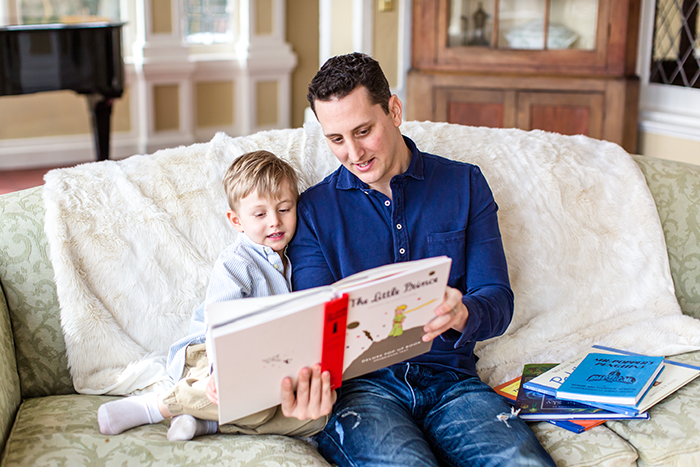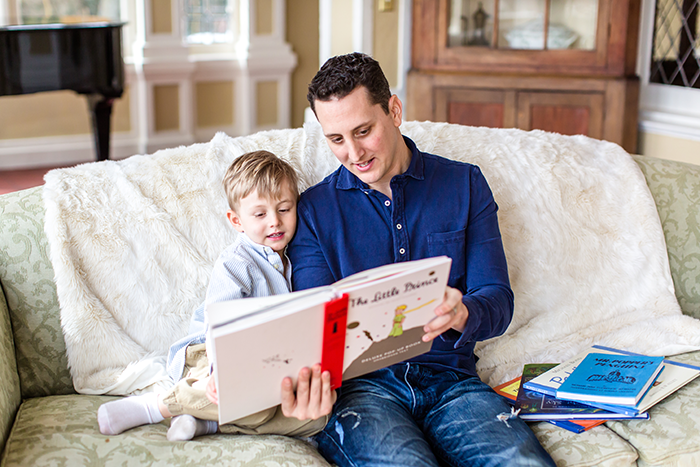
Is your child a reluctant reader? Pull out the picture books.
As the creators of Homer, the early reading app for young children, we’re often asked about how kids learn to read best. Over coffee a few weeks ago, a mom friend was telling me a sad but familiar tale. Her son, a kindergartner, was putting up a fight about reading. Once a boy who delighted in words and books and silly rhymes, her son found no joy in sounding out the word P-A-T, no matter how much his mom urged him on. “I just don’t know what to do, she told me. I’m worried he’s going to fall behind. Everyone in his class seems to be reading real books, and he won’t even sound out his letters.”
As her story went on, my friend mused wistfully on her son’s nursery, which was strewn with board books, pop up books, classic books, books on tape. “He absolutely LOVED everything about reading when he was little. I would read PD Eastman’s Go Dog Go over and over again and watch in delight as he waited for his favorite line, which we would read together. I never imagined that reading would be hard for him.”
As people who have been thinking about reading for many years, we weren’t surprised by my friend’s story. It happens all the time. A young child, who delights in books and stories, suddenly finds himself faced with the mechanics of letters and sounds and begins to see reading as a chore.
So how can parents support their children’s love of reading in the early years of formal schooling when reading skills become so important? Here are a few tips we’ve put together for parents who are struggling with the same worries my friend described:
1. Be patient.
Children learn at their own pace, in their own time. If you sense a child is frustrated by connecting letter sounds and symbols, put the lesson aside and take some time to draw a picture, do a dance, sing a song. There is no need for one kindergarten child to develop skills at the same pace as another. It’s no reflection on the superiority of one mother’s at-home teaching skills that her child is reading “above grade level” in the first year of formal school. Many very successful students don’t learn to read fluently until the end of 2nd grade (some even higher).
2. Respect the order in which foundational reading skills should be taught.
Learning to read happens in a very specific order, step by step, through explicit, direct instruction. What do all those words mean for a parent? This: children don’t just look at a word on a page– C-A-T– and understand that the word is a set of symbols that correspond with a certain set of sounds, and that when those sounds are pulled apart and sounded out individually, they make a word. Explicit phonics instruction means that someone (a teacher, a parent, an older sibling, even a digital learn to read program) explicitly talks to the child about the job each letters is doing, and about how those letters work together. Make sure your child is not being asked to read words whose individual elements she has never been introduced to.
3. Don’t put away the picture books!
We always offer this tip in any piece we write about early reading. Because learning to read is one of the most difficult skills a child will ever learn to do, it can be exhausting. Children are wired to walk and talk, but not to read. Brain scientists have discovered that the act of learning to read actually changes the wiring of the young brain. It’s hard work. Slow and steady wins the race. Keep the love of reading alive by not pushing a child too hard and allowing her at every chance to choose books to have read aloud to her. What better way to be reminded of the joy that independent reading will ultimately bring than having a beloved parent cuddle up and read that favorite book you almost know by heart?
4. Even before children learn to read and write on their own, they can tell stories.
Help your child experience the joy of reading and storytelling by honoring their own stories. Come up with a creative story prompt (Once upon a time there was a dragon everyone thought was mean, but he was really a nice dragon…) and ask your child to continue telling the story. Write down what your child says, mistakes and all. Ask your child to illustrate the story. Take time to create an “About the Author” page. Staple your child’s book together.
5. Listen to audiobooks together on long drives.
Platforms like Amazon have hundreds of young adult and children’s books to choose from, and the value of having a trained voice actor reading the stories aloud can bring alive the power of words and expression. In the process of listening, children learn important lessons about oral expression, how readers convey meaning through emphasis on certain words or long pauses. There’s a world of difference between listening to an audiobook and watching a movie. The words are doing the work, and your child will see just how good those words can be at painting a picture.
,


